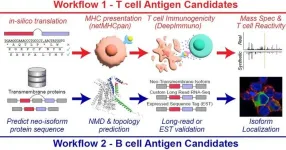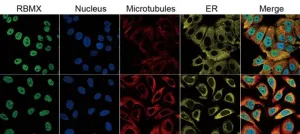(Press-News.org) A study of more than 25,000 U.S. dogs and 238 breeds has linked dog size to varying patterns of risk for health conditions over the course of a dog’s lifespan. Yunbi Nam of the University of Washington, U.S., and colleagues present these findings in the open-access journal PLOS ONE on January 17.
On average, smaller dogs tend to live longer than larger dogs. Evidence suggests that larger dogs do not tend to have more health conditions, but that dogs of different sizes may face different levels of risk for different conditions. However, more research is needed to clarify links between dog age, size, and disease prevalence.
To deepen understanding, Nam and colleagues analyzed survey data on 27,541 dogs representing 238 breeds, as reported by dog owners participating in the ongoing Dog Aging Project.
Overall, larger dogs in the study were more likely to have faced certain types of health conditions at some point in their lives, including cancer, bone-related disease, gastrointestinal problems, ear/nose/throat issues, neurological and endocrine conditions, and infectious diseases. Meanwhile, smaller dogs were more likely to have experienced ocular, cardiac, liver/pancreas and respiratory diseases. History of kidney/urinary disease did not differ significantly for larger versus smaller dogs.
For many types of conditions—including cancer, ocular, cardiac, orthopedic, and ear/nose/throat conditions—different dog sizes were associated with differing patterns of risk over the course of a dog’s lifespan.
The results held up even after the researchers statistically accounted for the dogs’ sex, where they lived, and whether they were purebred or mixed-breed.
The researchers note that this study does not confirm any causal relationship between dog size, age, and disease. Still, the findings could help lead to deeper understanding of the types of conditions that may underlie the lower lifespan of larger dogs. For instance, within the disease categories explored in this study, future research could home in on age and size patterns associated with specific conditions.
The authors add: “These results provide insights into the disease categories that may contribute to reduced lifespan in larger dogs and suggest multiple further avenues for further exploration.”
#####
In your coverage please use this URL to provide access to the freely available article in PLOS ONE: https://journals.plos.org/plosone/article?id=10.1371/journal.pone.0295840
Citation: Nam Y, White M, Karlsson EK, Creevy KE, Promislow DEL, McClelland RL, et al. (2024) Dog size and patterns of disease history across the canine age spectrum: Results from the Dog Aging Project. PLoS ONE 19(1): e0295840. https://doi.org/10.1371/journal.pone.0295840
Author Countries: USA
Funding: This research is based on publicly available data collected by the Dog Aging Project, which is supported by U19 grant AG057377 from the National Institute on Aging, a part of the National Institutes of Health, and by additional grants and private donations. The funders had no role in study design, data collection and analysis, decision to publish, or preparation of the manuscript.
END
Big dogs versus small dogs: Which sizes face higher risks of which diseases?
New study could aid understanding of why smaller dogs tend to live longer
2024-01-17
ELSE PRESS RELEASES FROM THIS DATE:
URI professor leads effort demonstrating success of new technology in conducting deep-sea research on fragile organisms
2024-01-17
KINGSTON, R.I. – Jan. 17, 2024 – A University of Rhode Island professor of Ocean Engineering and Oceanography, along with a multidisciplinary research team from multiple institutions, successfully demonstrated new technologies that can obtain preserved tissue and high-resolution 3D images within minutes of encountering some of the most fragile animals in the deep ocean.
URI Professor Brennan Phillips, the principal investigator on the project, and a team of 15 researchers from six institutions, including URI, have shown ...
Woolly mammoth movements tied to earliest Alaska hunting camps
2024-01-17
Researchers have linked the travels of a 14,000-year-old woolly mammoth with the oldest known human settlements in Alaska, providing clues about the relationship between the iconic species and some of the earliest people to travel across the Bering Land Bridge.
Scientists made those connections by using isotope analysis to study the life of a female mammoth, named Élmayųujey'eh, by the Healy Lake Village Council. A tusk from Elma was discovered at the Swan Point archaeological site in Interior Alaska. Samples from the tusk revealed details about Elma and the roughly 1,000-kilometer journey she took through Alaska ...
Researchers chronicle lifetime travels of a single woolly mammoth which wandered the north more than 14,000 years ago
2024-01-17
Attention editors: Embargoed by Science Advances until Wednesday, January 17th, 2 p.m. eastern
High resolution photos, background footage, video clips can be downloaded at this link: https://photos.app.goo.gl/Sn4unWFGHb5ULdeB9
Hamilton, ON, Jan. 17, 2024 – An international team of researchers from McMaster University, University of Alaska Fairbanks and the University of Ottawa has tracked and documented the movements and genetic connections of a female woolly mammoth that roamed the earth more than 14,000 years ago.
She travelled ...
New research tool seeks to accelerate hunt for cancer immunotherapy targets
2024-01-17
An innovative computational tool dubbed “SNAF” may help the research world bring the emerging promise of cancer immunotherapy to a wider range of patients, according to a study published Jan. 17, 2024, in Science Translational Medicine.
The research tool, called the Splicing Neo Antigen Finder (SNAF), was developed by a multidisciplinary team of researchers from Cincinnati Children’s and the University of Virginia. The project was led by Guangyuan Li, PhD, and Nathan Salomonis, PhD, both with the Division of Biomedical Informatics at Cincinnati ...
SARS-CoV-2 can infect dopamine neurons causing senescence
2024-01-17
A new study reported that SARS-CoV-2, the virus that causes COVID, can infect dopamine neurons in the brain and trigger senescence—when a cell loses the ability to grow and divide. The researchers from Weill Cornell Medicine, Memorial Sloan Kettering Cancer Center and Columbia University Vagelos College of Physicians and Surgeons suggest that further research on this finding may shed light on the neurological symptoms associated with long COVID such as brain fog, lethargy and depression.
The findings, published in Cell Stem Cell on Jan. 17, show that dopamine neurons infected with SARS-CoV-2 stop working and send out chemical signals that cause ...
The metalens meets the stars
2024-01-17
Metalenses have been used to image microscopic features of tissue and resolve details smaller than a wavelength of light. Now they are going bigger.
Researchers at the Harvard John A. Paulson School of Engineering and Applied Sciences (SEAS) have developed a 10-centimeter-diameter glass metalens that can image the sun, the moon and distant nebulae with high resolution. It is the first all-glass, large-scale metalens in the visible wavelength that can be mass produced using conventional CMOS fabrication technology.
The ...
New U of A-based study to examine very rare adverse events linked to COVID-19 vaccines
2024-01-17
EDMONTON — A University of Alberta professor is co-leading a new international vaccine safety network to examine why some people who received a COVID-19 vaccine experienced very rare adverse events associated with the vaccine.
The International Network of Special Immunization Services (INSIS), based at the U of A, is a consortium of academic medical centres around the world coming together to study very rare adverse events after vaccination. An adverse reaction is considered very rare when it affects less than .001 per cent of the population.
“The bar for safety with vaccines is very high because we’re giving them ...
$24 million grant to extend Study of Healthy Aging in African Americans (STAR)
2024-01-17
Researchers at UC Davis Health and Kaiser Permanente Division of Research have received a $24 million grant from the National Institute on Aging, part of the National Institutes of Health (NIH), to continue the Study of Healthy Aging in African Americans (STAR) for an additional five years.
STAR, which launched in 2017, follows a group of approximately 750 older adults to understand how behaviors and lifestyle may increase the risk of Alzheimer’s disease and related dementias for Black and African Americans. The study ...
Metastatic breast cancer treatments have aided decline in deaths, Stanford Medicine-led study finds
2024-01-17
Deaths from breast cancer dropped 58% between 1975 and 2019 due to a combination of screening mammography and improvements in treatment, according to a new multicenter study led by Stanford Medicine clinicians and biomedical data scientists.
Nearly one-third of the decrease (29%) is due to advances in treating metastatic breast cancer —a form that has spread to other areas of in the body and is known as stage 4 breast cancer or recurrent cancer. Although these advanced cancers are not considered curable, women with metastatic disease are living longer than ever.
The analysis helps cancer researchers assess where to focus future efforts and resources.
“We’ve ...
Aberrant RBMX expression relevant for cancer prognosis and immunotherapy response
2024-01-17
“In the future, targeting of RBMX may be a novel method in cancer therapy.”
BUFFALO, NY- January 17, 2024 – A new research paper was published in Aging (listed by MEDLINE/PubMed as "Aging (Albany NY)" and "Aging-US" by Web of Science) Volume 16, Issue 1, entitled, “Aberrant RBMX expression is relevant for cancer prognosis and immunotherapy response.”
Cancer accounts for the highest rates of morbidity and mortality worldwide. RNA binding motif protein X-linked (RBMX) is a nuclear ...
LAST 30 PRESS RELEASES:
Scientists discover ‘platypus galaxies’ in the early universe
Seeing thyroid cancer in a new light: when AI meets label-free imaging in the operating room
Neutrophil-to-lymphocyte ratio may aid risk stratification in depressive disorder
2026 Seismological Society of America Annual Meeting
AI-powered ECG analysis offers promising path for early detection of chronic obstructive pulmonary disease, says Mount Sinai researchers
GIMM uncovers flaws in lab-grown heart cells and paves the way for improved treatments
Cracking the evolutionary code of sleep
Medications could help the aging brain cope with surgery, memory impairment
Back pain linked to worse sleep years later in men over 65, according to study
CDC urges ‘shared decision-making’ on some childhood vaccines; many unclear about what that means
New research finds that an ‘equal treatment’ approach to economic opportunity advertising can backfire
Researchers create shape-shifting, self-navigating microparticles
Science army mobilizes to map US soil microbiome
Researchers develop new tools to turn grain crops into biosensors
Do supervised consumption sites bring increased crime? Study suggests that’s a myth
New mass spec innovation could transform research
Maternal nativity, race, and ethnicity and infant mortality in the US
Migration-related trauma among asylum seekers exposed to the migrant protection protocols
Jupiter’s moon Europa has a seafloor that may be quiet and lifeless
SwRI upgrades nuclear magnetic resonance laboratory for pharmaceutical R&D
House sparrows in northern Norway can help us save other endangered animals
Crohn's & Colitis Foundation survey reveals more than 1/3 of young adults with IBD face step therapy insurance barriers
Tethered UAV autonomous knotting on environmental structures for transport
Decentralized social media platforms unlock authentic consumer feedback
American Pediatric Society announces Vanderbilt University School of Medicine as host institution for APS Howland Visiting Professor Program
Scientists discover first method to safely back up quantum information
A role for orange pigments in birds and human redheads
Pathways to net-zero greenhouse gas emissions for Southeast Asia
A JBNU–KIMS collaborative study on a cost-effective alloy matches superalloys for power plants and energy infrastructure
New study overturns long-held model of how plants coordinate immune responses.
[Press-News.org] Big dogs versus small dogs: Which sizes face higher risks of which diseases?New study could aid understanding of why smaller dogs tend to live longer










